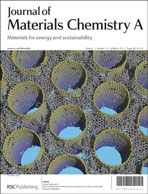Nanocasting of hierarchical nanostructured porous carbon in molecular dynamics simulation
Abstract
We developed a model template method mimicking the nanocasting process by introducing cylindrical templates during the quenched molecular dynamics process [Y. Shi, J. Chem. Phys., 2008, 128, 234707] to generate hierarchical nanostructured porous carbons (HNPCs). Bimodal pore size distributions with both mesopores (from templates) and micropores (from the direct quenching of the carbon source) were well developed during the mimetic nanocasting process. The structure and properties of the nanocast HNPCs can be tailored by various control parameters, such as the template–carbon interaction strength (εt), the template radius (rt), the number density of the carbon source (ρ0) and the quench rate (qr). The mesopore wall is made of graphitic carbons, whose morphology can be well-controlled by εt and high temperature heat treatments, while the microporous structure can be engineered by ρ0 and qr. The crystallinity of the mesopore wall and the structural integrity of HNPCs (characterized by the number of bridging bonds between the mesopore wall and the microporous region) can be balanced by fine-tuning the control parameters. The mimetic nanocasting method allows us to generate atomic models to quantify the relationship between the structure and properties of HNPCs, and to provide guidelines for identifying the optimal synthesis parameters for HNPCs with desired properties.

- This article is part of the themed collection: 2013 Journal of Materials Chemistry A Hot Papers

 Please wait while we load your content...
Please wait while we load your content...